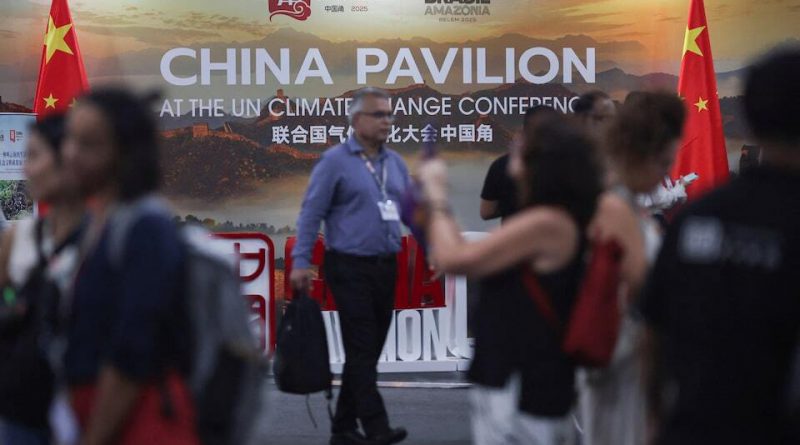China Expands Climate Influence as U.S. Skips Major Global Summit
China steps into a more prominent climate leadership role at COP30, strengthening its diplomatic and technological presence as the United States remains absent from the annual summit for the first time in decades
China is taking on a more visible and influential role at the COP30 climate summit in Belem, emerging as a central figure in global climate diplomacy. Its presence has grown notably at a moment when the United States has chosen not to send a high-level delegation to the conference.
The country’s pavilion occupies a prime location at the entrance of the summit grounds. It showcases major renewable-energy companies, technology demonstrations, and presentations designed to highlight China’s expanding clean-energy capabilities.
Executives from leading Chinese firms delivered messages focused on cooperation, long-term sustainability, and the shared global responsibility to reduce emissions. Diplomats also worked quietly to support constructive negotiations and encourage progress among participating nations.
Observers at the summit noted that the responsibilities once associated with the U.S. now appear to be shifting toward China. Many analysts believe this reflects broader geopolitical changes and China’s fast-growing strength in clean-energy manufacturing and innovation.
Officials from global organizations stated that China’s dominance in renewable energy and electric vehicles is enhancing its diplomatic influence. Its role has evolved from a low-profile participant to a key player shaping expectations and discussions at these international gatherings.
This shift comes as the United States steps back from climate negotiations, with its government prioritizing economic and security concerns over long-term climate goals. Critics warn that withdrawing from the process leaves strategic space for others to shape global climate policy and supply-chain direction.
Governors, industry leaders, and environmental observers have voiced concern that the U.S. may lose competitive ground. They say China’s rapid investment in renewable-energy production, battery technologies, and clean-energy supply chains is giving it a clear advantage.
China’s pavilion this year is larger, more interactive, and far more visible than in past summits. Visitors encounter product displays, presentations from major renewable-energy companies, and exhibits intended to promote collaboration with governments and non-profits.
Executives from major firms highlighted China’s ambition to help accelerate global climate cooperation. They emphasized the importance of building a clean, sustainable future through technological innovation and large-scale renewable deployment.
Major companies from China’s renewable-energy sector, including battery producers and solar manufacturers, participated with detailed presentations. Electric-vehicle makers showcased new hybrid models developed for international markets, including vehicles produced locally in Brazil.
Summit organizers praised China for its role in advancing affordable clean-energy technologies. Officials said large-scale Chinese production has helped bring down global costs of renewable-energy equipment and improved access for developing nations.
Delegates involved in negotiations said China’s influence extends behind the scenes as it works to support agreement among countries.
Without U.S. leadership, China has helped guide discussions, encourage consensus on agendas, and maintain momentum in the negotiations.
Diplomats noted that China has gradually taken on a stabilizing role within the climate framework. They argue that China has strong incentives to maintain progress since its own economy is deeply invested in clean-energy industries.
Others observed that China acted earlier than usual this year by helping smooth the negotiation agenda before formal discussions began.
This marks a shift from previous years, when China typically engaged only on issues directly affecting its national interests.
Experts said China’s ability to unite developing countries gives it additional influence.
Its partnerships across the Global South and its role in large-scale infrastructure and energy projects have strengthened its position.
However, some analysts believe China’s climate leadership has limits, pointing to the need for more ambitious emissions-reduction commitments. Recent announcements outlining modest reductions by 2035 prompted calls for stronger targets aligned with global goals.
Still, many climate watchers argue that China’s technological leadership itself plays a major political role. They say the country’s massive manufacturing capacity makes global climate pledges more achievable by lowering costs and expanding access.
As COP30 advances, China’s visibility and engagement appear to reflect a long-term shift in global climate dynamics.
With the U.S. stepping back, China’s ability to influence negotiations and shape policy has grown, elevating it as a central player in climate discussions.



